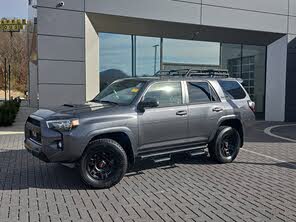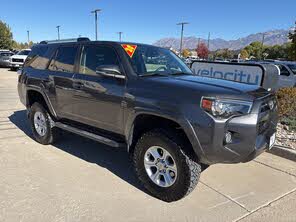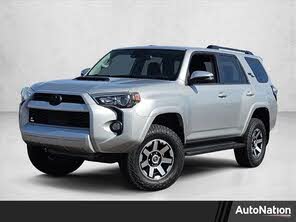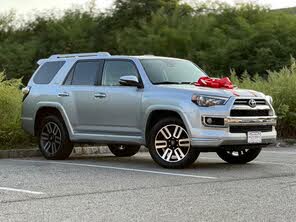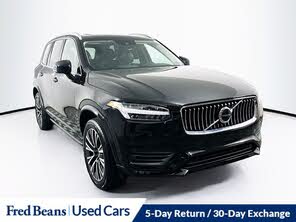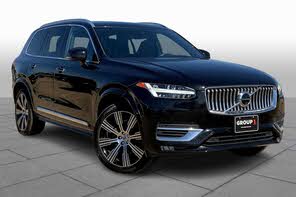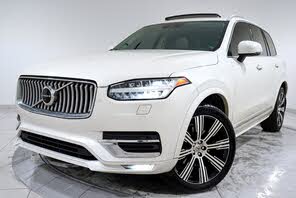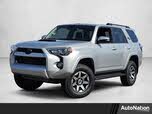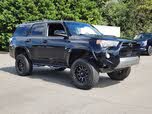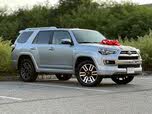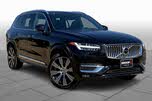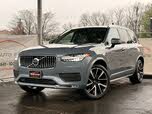2020 Toyota 4Runner vs 2020 Volvo XC90
Overview | |
MSRP$48,350 | MSRP$36,120 |
Listings305 | Listings788 |
Ratings & Reviews | |
User Reviews | User Reviews |
Expert reviews8.5 out of 10 | Expert reviews6.8 out of 10 |
Pros
Cons
| Pros
Cons
|
2020 Volvo XC90 Reviews SummaryThe XC90 has been one of our favorite family shuttles for 18 model years. This 3-row Volvo continues for 2020 as it was during its 2016 redesign, which brought dramatic new design language, chassis architecture, electrified powertrains, infotainment, and semi-automated driving capability. Among midsize SUVs, the XC90 is among the few I would recommend without any hesitation. Families who can afford to splurge will find a stylish and pampering truck that's built upon decades of safety research, which very few automakers can match. | |
2020 Toyota 4Runner Reviews SummaryEven in its expensive Limited trim, the Toyota 4Runner remains clearly purpose-built for tackling terrain. Whether on a dusty cow path or snowy mountain road, the 4Runner looks most in its element when its outside the typical car’s comfort zone. For 2020, Toyota keeps enough chrome and leather available to market the 4Runner as a rough-and-tumble luxury alternative, but shoppers considering one had better have a real need for 4-wheel drive. | |
No video found | |
Popular Features & Specs | |
Engine2.0L 250 hp I4 | Engine4.0L 270 hp V6 |
Drive TrainFWD | Drive Train4X2 |
Seating Capacity7 | Seating Capacity7 |
Horsepower250 hp @ 5500 rpm | Horsepower270 hp @ 5600 rpm |
MPG City21 | MPG City16 |
MPG Highway30 | MPG Highway19 |
Engine | |
Engine Name2.0L 250 hp I4 | Engine Name4.0L 270 hp V6 |
Torque258 lb-ft @ 1500 rpm | Torque278 lb-ft @ 4400 rpm |
Horsepower250 hp @ 5500 rpm | Horsepower270 hp @ 5600 rpm |
DrivetrainFWD | Drivetrain4X2 |
Fuel Economy | |
MPG City21 | MPG City16 |
MPG Highway30 | MPG Highway19 |
Interior | |
Seating Capacity7 | Seating Capacity7 |
Key Features | |
Sunroof/MoonroofStandard | Sunroof/Moonroof |
Safety | |
Front Crash Overall5 | Front Crash Overall4 |
Side Crash Overall5 | Side Crash Overall5 |
Dimensions & Capacity | |
Cargo Space15.8 cu ft | Cargo Space47.2 cu ft |
Curb Weight4375 lbs | Curb Weight4400 lbs |
Height69.9 in | Height71.5 in |
Length195.0 in | Length190.2 in |
Width84.3 in | Width75.8 in |
Wheelbase117.5 in | Wheelbase109.8 in |
Maximum Payload1210 lbs | Maximum Payload1700 lbs |
Number of doors4 | Number of doors4 |
Maximum Towing Capacity4000 lbs | Maximum Towing Capacity5000 lbs |
Standard Towing Capacity | Standard Towing Capacity5000 lbs |
Overview | ||
MSRP | $48,350 | $36,120 |
Listings | ||
Ratings & Reviews | ||
User reviews | ||
Expert reviews | 8.5 out of 10Read full review | 6.8 out of 10Read full review |
Pros & cons | Pros
Cons
| Pros
Cons
|
Summary | The XC90 has been one of our favorite family shuttles for 18 model years. This 3-row Volvo continues for 2020 as it was during its 2016 redesign, which brought dramatic new design language, chassis architecture, electrified powertrains, infotainment, and semi-automated driving capability. Among midsize SUVs, the XC90 is among the few I would recommend without any hesitation. Families who can afford to splurge will find a stylish and pampering truck that's built upon decades of safety research, which very few automakers can match. | Even in its expensive Limited trim, the Toyota 4Runner remains clearly purpose-built for tackling terrain. Whether on a dusty cow path or snowy mountain road, the 4Runner looks most in its element when its outside the typical car’s comfort zone. For 2020, Toyota keeps enough chrome and leather available to market the 4Runner as a rough-and-tumble luxury alternative, but shoppers considering one had better have a real need for 4-wheel drive. |
Video | No video found | |
Popular Features & Specs | ||
Engine | 2.0L 250 hp I4 | 4.0L 270 hp V6 |
Drive Train | FWD | 4X2 |
Seating Capacity | 7 | 7 |
Horsepower | 250 hp @ 5500 rpm | 270 hp @ 5600 rpm |
MPG City | 21 | 16 |
MPG Highway | 30 | 19 |
Engine | ||
Engine Name | 2.0L 250 hp I4 | 4.0L 270 hp V6 |
Torque | 258 lb-ft @ 1500 rpm | 278 lb-ft @ 4400 rpm |
Horsepower | 250 hp @ 5500 rpm | 270 hp @ 5600 rpm |
Drivetrain | FWD | 4X2 |
Fuel Economy | ||
MPG City | 21 | 16 |
MPG Highway | 30 | 19 |
Interior | ||
Seating Capacity | 7 | 7 |
Key Features | ||
Sunroof/Moonroof | Standard | |
Safety | ||
Front Crash Overall | 5 | 4 |
Side Crash Overall | 5 | 5 |
Dimensions & Capacity | ||
Cargo Space | 15.8 cu ft | 47.2 cu ft |
Curb Weight | 4375 lbs | 4400 lbs |
Height | 69.9 in | 71.5 in |
Length | 195.0 in | 190.2 in |
Width | 84.3 in | 75.8 in |
Wheelbase | 117.5 in | 109.8 in |
Maximum Payload | 1210 lbs | 1700 lbs |
Number of doors | 4 | 4 |
Maximum Towing Capacity | 4000 lbs | 5000 lbs |
Standard Towing Capacity | 5000 lbs | |
The 2020 Volvo XC90 had a design rooted in sophistication and elegance, standing as a testimony to the apogee of Volvo's modern design philosophy. Unlike the boxy sedans and wagons from the ‛80s and ‛90s, this SUV showed how a big, tall vehicle could still radiate an aura of beauty typically reserved for sleek sedans. The design details highlighted the Swedish touch, with the R-Design trim sporting blacked-out honeycomb grille treatment, Thor's hammer LED headlights, black window surrounds, mirrors, an aggressive chin spoiler, and eye-catching 22-inch rims. Such features lent the XC90 a distinct, powerful presence.
Inside, the XC90 continued to impress with a thoughtful blend of luxurious materials such as beige leather and aluminum. Volvo also allowed for varied interior options, including matte wood trim and wool fabric seats in the Inscription models, or leather with aluminum or carbon-fiber trim in the R-Design. The seats offered unmatched comfort, echoing the supportive and enveloping design lineage since the 1998 S70. The cabin’s sophistication was further highlighted by rich leather on the dash and doors, padded materials for enhanced safety and comfort, and finer details like the Swedish flag tag. The overall simplicity and quality of the interior were themes that Volvo executed with finesse, setting a benchmark that competitors like Mercedes, Audi, Lexus, or Acura struggled to match.
In contrast, the 2020 Toyota 4Runner’s exterior was all about robust, utilitarian appeal. It featured tall slab sides, a high beltline, short overhangs, and a pronounced front fascia, which cumulatively contributed to its timeless design. The design ethos was similar to that of an XJ Jeep Cherokee, focusing more on functionality rather than visual flash. The 4Runner's flared wheel wells were practical, built to accommodate bulky off-road tires, while its short overhangs made it capable of handling steep slopes. The hood scoop, especially prominent in the TRD trims, was primarily aesthetic rather than functional.
Trim levels ranged from SR5 to the TRD Pro and Limited, with special editions like Nightshade and Venture adding unique stylistic touches and off-road functionalities. Our Limited trim test model aimed more at offering comfort than rugged capability, boasting leather upholstery. Despite these premium touches, the 4Runner's utilitarian roots were evident, with ample plastic surfaces and a seating design meant for trail tackling, rather than long highway cruises. The high seating position, body-on-frame construction, and chunky control knobs inside enhanced this no-nonsense, robust appeal.


















The 2020 Volvo XC90 presented various engine options, all based on a turbocharged 2.0-liter inline-4 coupled with an 8-speed automatic transmission. It featured three powertrain configurations: T5, T6, and T8 plug-in hybrid. The T5 churned out 250 horsepower and 258 pound-feet of torque, which struggled under the XC90’s heavy frame. The T6, enhanced with a supercharger, produced a more robust 316 hp and 295 lb-ft, making it more apt for fast-paced traffic. Additionally, the Polestar tune could increase the T6’s output to 330 hp and 325 lb-ft. However, despite these enhancements, acceleration wasn’t exceptionally quick. The T8 plug-in hybrid offered 400 hp and 472 lb-ft, but the extra weight and limited electric range diminished its overall efficiency and speed gains. Fuel economy figures stood unimpressive, with the T6 AWD rated at 18 mpg city, 26 highway, and 21 combined, reflecting a thirsty nature.
In comparison, the 2020 Toyota 4Runner offered a single powertrain: a 4.0-liter V6 engine producing 270 horsepower and 278 pound-feet of torque with a 5-speed automatic transmission. This sturdy engine was not known for smoothness or efficiency but was built for reliability and longevity, suitable for towing up to 5,000 pounds. Fuel economy lagged considerably, with an EPA rating of 16 mpg city, 19 highway, and 17 combined. The 4Runner shined off-road, thanks to its body-on-frame construction and advanced traction systems like Toyota’s CRAWL control and Multi-Terrain Select. The vehicle’s handling on pavement involved significant body roll and imprecise steering, emphasizing its off-road prowess over on-road finesse.
The 2020 Volvo XC90 had an elegantly laid-out cabin with its Sensus infotainment system providing improved responsiveness compared to earlier models. The system’s central touchscreen housed essential controls, including those for climate and seat adjustments, reducing physical button clutter. While mostly user-friendly, a few settings required navigating deeper menus. Seating was a highlight, with seven seats as standard, and an integrated booster in the second row, a unique Volvo touch.
Volvo’s six-seat configuration, available in certain trims, featured generous legroom and all-day support in the first and second rows. However, the third row was suitable only for small children. Cargo space was considerable, with up to 85.7 cubic feet available when the second and third rows were folded. In terms of visibility, sightlines from the driver's seat were superior.
The 2020 Toyota 4Runner focused heavily on practicality and off-road readiness. Its tall seating position, although cumbersome for entry and exit, provided a commanding view of the road. The cabin was fitted with large knobs and buttons for easy control of the HVAC system and stereo, making them user-friendly even when the vehicle was jostling off-road. Despite its dimensions, the 4Runner boasted a surprisingly tidy turning radius of 18 feet, 7 inches, enhancing maneuverability.
While the 4Runner offered an optional third-row seat in non-TRD and non-Venture trims, these seats were best suited for short trips due to their lack of comfort and legroom. The design prioritized practical off-road use over passenger comfort. Cargo capacity was substantial and comparable to the XC90's, making it serviceable for both off-road adventures and day-to-day utility.
The 2020 Volvo XC90 excelled in its technology offerings. Volvo Pilot Assist came standard, integrating adaptive cruise control with lane-keep assist for semi-automated driving, forming a reliable system particularly useful in lower-speed traffic. The four-zone climate control was another standard feature, ensuring optimal comfort. However, the Bowers & Wilkins stereo system was a standout addition, remarkable for its sound quality and customizability. Equipped with 19 speakers and a 1,400-watt power system, enriched by the option to simulate the acoustics of the Gothenburg Concert Hall, it was a premium addition that delighted audiophiles. The portrait-oriented touchscreen also improved navigation by displaying more of the road ahead, though onboard apps were notably slow to load.
Meanwhile, the 2020 Toyota 4Runner, historically limited in its tech offerings, made strides by introducing a new 8-inch touchscreen compatible with Apple CarPlay and Android Auto. This move significantly improved usability as drivers could leverage familiar, smartphone-based navigation and media apps instead of Toyota’s occasionally convoluted native system. Other technological features included Amazon Alexa integration, Bluetooth connectivity, as well as subscription services like Sirius XM Radio and WiFi Connect. Higher trims offered features like a JBL stereo and onboard navigation, though the native system’s usability lagged behind competitors.
The 2020 Volvo XC90 boasted top-notch safety features, earning high marks from NHTSA and IIHS, although it fell short of the "+" designation due to headlight performance. It came standard with an array of advanced features, including forward emergency braking, pedestrian detection, driver-attention monitor, blind-spot monitoring, and traffic-sign recognition. Volvo's long-standing reputation for building safe vehicles was bolstered by its use of high-strength steel and comprehensive airbag coverage, showcasing its unwavering commitment to passenger protection over the years.
The 2020 Toyota 4Runner also saw improvements in safety, integrating Toyota Safety Sense P (TSS-P) for the first time. This suite of ADAS included adaptive cruise control, lane-departure alert, pre-collision system with pedestrian detection, and automatic high beams. The vehicle came equipped with eight standard airbags, contributing to occupant safety. Despite these enhancements, the 4Runner's safety ratings were mixed. NHTSA awarded it four out of five stars overall but only three stars in rollover tests. Similarly, IIHS gave it top marks in most crash tests, save for the small overlap front: driver-side test, where it scored a Marginal.
CarGurus highlights

According to CarGurus experts, the overall rating for the 2020 Volvo XC90 is 8.5 out of 10, while the 2020 Toyota 4Runner scores 6.8 out of 10. The final recommendation, based on these ratings, leans towards the Volvo XC90. The XC90's blend of modern design, luxurious interior, advanced technology, and top-tier safety features makes it a more compelling choice for most consumers, especially those seeking a well-rounded SUV for both family and personal use. While the Toyota 4Runner is unmatched for off-road capabilities, its overall package doesn't quite stack up against the refined and sophisticated Volvo XC90.
Choose the 2020 Toyota 4Runner if:
- You need a robust vehicle optimized for off-road adventures and rugged terrain.
- Reliability and longevity in an engine matter more than fuel efficiency.
- You require practical, functional controls and a spacious cargo area for outdoor gear.
Choose the 2020 Volvo XC90 if:
- You prioritize an elegant and luxurious interior with superior material quality and craftsmanship.
- Advanced driver-assist systems and cutting-edge safety features are a top concern.
- You appreciate high-end sound systems and modern technology integrations.
CarGurus highlights

According to CarGurus experts, the overall rating for the 2020 Volvo XC90 is 8.5 out of 10, while the 2020 Toyota 4Runner scores 6.8 out of 10. The final recommendation, based on these ratings, leans towards the Volvo XC90. The XC90's blend of modern design, luxurious interior, advanced technology, and top-tier safety features makes it a more compelling choice for most consumers, especially those seeking a well-rounded SUV for both family and personal use. While the Toyota 4Runner is unmatched for off-road capabilities, its overall package doesn't quite stack up against the refined and sophisticated Volvo XC90.
Choose the 2020 Toyota 4Runner if:
Shop Now- You need a robust vehicle optimized for off-road adventures and rugged terrain.
- Reliability and longevity in an engine matter more than fuel efficiency.
- You require practical, functional controls and a spacious cargo area for outdoor gear.
Choose the 2020 Volvo XC90 if:
Shop Now- You prioritize an elegant and luxurious interior with superior material quality and craftsmanship.
- Advanced driver-assist systems and cutting-edge safety features are a top concern.
- You appreciate high-end sound systems and modern technology integrations.

By: CarGurus + AI
At CarGurus, our team of experienced automotive writers remain at the heart of our content operation, conducting hands-on car tests and writing insightful guides that are backed by years of industry experience. To complement this, we are harnessing AI to make our content offering more diverse and more helpful to shoppers than ever. To achieve this, our AI systems are based exclusively on CarGurus content, ratings and data, so that what we produce is both unique to CarGurus, and uniquely helpful to car shoppers.

